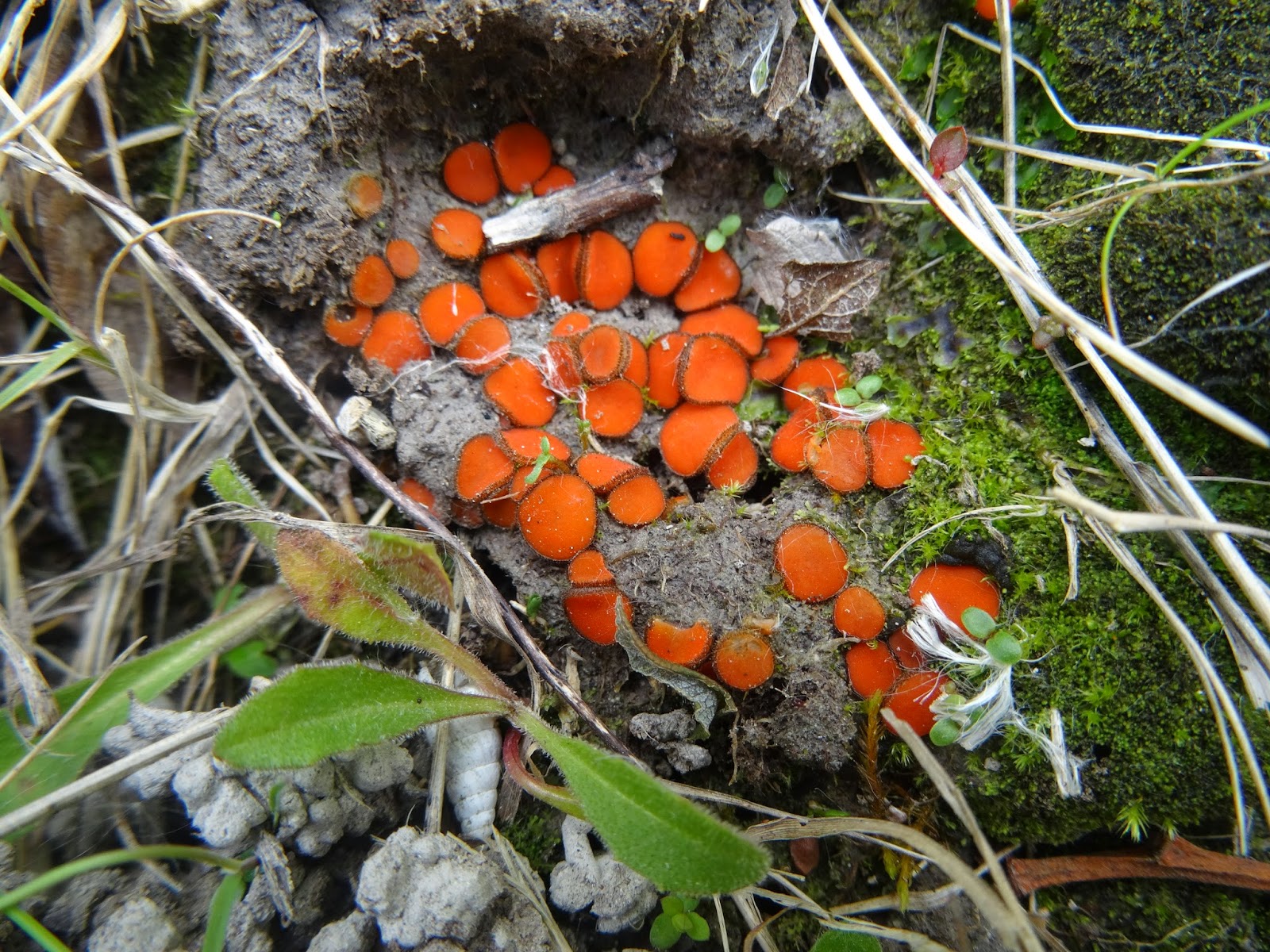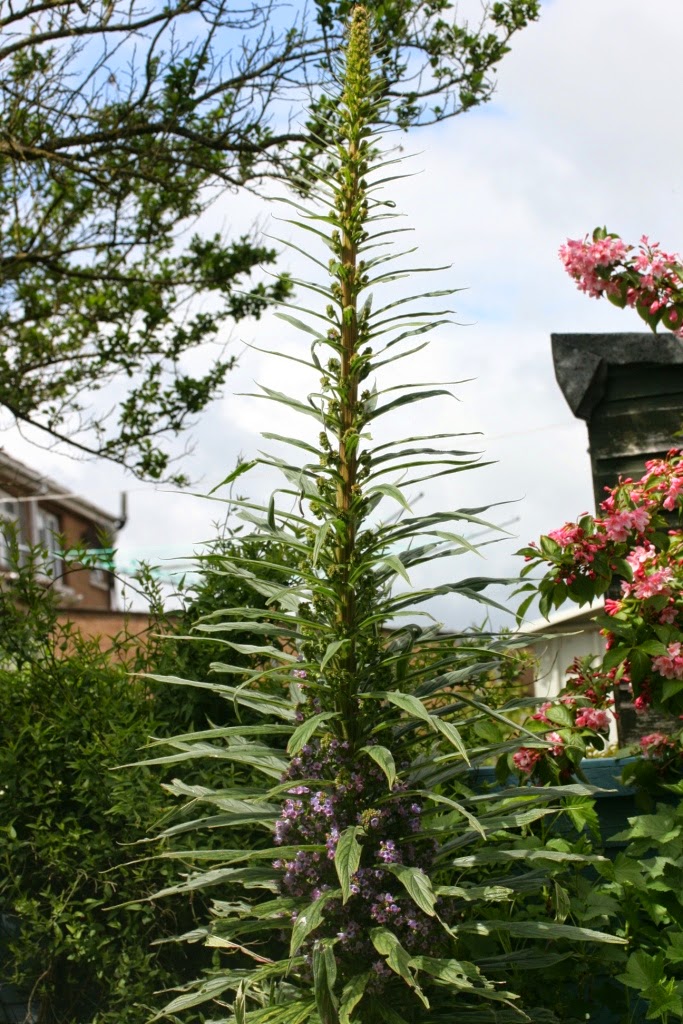On Friday, while rummaging about in an old meadow, just north of Aberdare, I came across this sawfly larva, on the flower stem of Ribwort Plantain. I haven't been able to identify it, so I'd be grateful if someone could give me some pointers. Bonus points for the identity of the weevil.
I also came across this colourful spider in a young birch. I know Adam is going to tell me it is immature or not showing the main diagnostic feature, which is fine, but what stands out for me is the shape of the tip of the abdomen. I assume this is a sign of immaturity.
We welcome contributions from anyone with an interest in wildlife. Our aim is that the blog will be used for sharing sightings, photographs, events, and any other aspects of natural history interest in the East Glamorgan area of Vice County 41. This covers Bridgend, Rhondda Cynon Taff, Merthyr Tydfil, Vale of Glamorgan, Cardiff and the western part of Caerphilly.
Southern Marsh Orchids

Saturday, 31 May 2014
Thursday, 22 May 2014
GBG excursion part 2
Here's a few more pics from the weekend:
Lathyrus nissolia (Grass Vetchling) which is surprisingly a member of the pea family. The first photo shows a very young flower bud forming in the base of the leaf.
Myosotis discolor (Changing Forget-me-not). So called because the flowers change from a pale yellow to blue.
Ranunculus parviflorus (Small-flowered Buttercup).

Orobanche minor (Common Broomrape)

And finally a Dingy Skipper, of which there were many enjoying the sun!

Lathyrus nissolia (Grass Vetchling) which is surprisingly a member of the pea family. The first photo shows a very young flower bud forming in the base of the leaf.
Myosotis discolor (Changing Forget-me-not). So called because the flowers change from a pale yellow to blue.

Orobanche minor (Common Broomrape)

And finally a Dingy Skipper, of which there were many enjoying the sun!

Monday, 19 May 2014
Glamorgan Botany Group excursion to Rhoose Point Pt 1
The Glamorgan Botany Group held a field meeting at Rhoose on Saturday, and I was lucky enough to tag along and hopefully learnt a few new things! I say Rhoose, rather than Rhoose Point because we covered some of the less well-trodden and less known areas including the old quarry south of Rhoose village. I will post groups of photos over the next few days of the highlights from the day. Here are the first few:
Field Madder(I think!)
OK, it's not a plant, but there aren't many fungi around so it caught my eye and it's very photogenic! Eyelash Fungus, Scutellinia scutellari
Autumn Ladies Tresses
Lastly, the obligatory Orchid-filled panorama from the Point. These are Southern Marsh Orchids. Give it another couple of weeks and it will be even better!
Field Madder(I think!)
Lastly, the obligatory Orchid-filled panorama from the Point. These are Southern Marsh Orchids. Give it another couple of weeks and it will be even better!
Thursday, 15 May 2014
Tree Bumblebees near you
Well Tree Bumblebee workers have been on the wing in my garden in West Bridgend since last week-end, so they ought to be about everywhere in South Wales soon, if not already.
Bumblebees generally seem to be a bit slow this year, which makes me wonder what hibernation survival was like after the wettest winter on record. Perhaps a fair proportion of the gravid queens drowned?
And the reason for bothering to make all this effort is to get bumblebees feeding at eye height about a foot away from the garden path, and turning up to pollinate all the fruit bushes, raspberry canes and everything else I grow.
So the first Tree Bumblebee worker of the year in the garden was this individual
Bumblebees generally seem to be a bit slow this year, which makes me wonder what hibernation survival was like after the wettest winter on record. Perhaps a fair proportion of the gravid queens drowned?
To get really good views of bumblebees I have been growing the Jewel of Tenerife
or as I have now seen it labelled Giant Viper's Bugloss (Echium pininana) with some success for the last decade and more. They can
take up to 5 years to flower, but when they do, you and everybody else in the
vicinity knows about it, as their flowers spikes are between 16-20 feet tall. They
seem to be remarkably wind tolerant, never having lost one to being uprooted, even though part of our roof blew off. They are monocarpic, so they died once they have
flowered, but seed profusely before doing so.
I have had to wait only 4 years for this one, as all my plants got wiped out in the 2010 winter, and I was a bit slow in starting to plant again.
As you can see, the flowers are now open at the bottom, and will continue to repeat flower there as the rest of the column comes into flower. These flowers last until the bumblebees are ready to go into hibernation in the autumn in October/November depending on the season. So ideal for the little beasts.
And the reason for bothering to make all this effort is to get bumblebees feeding at eye height about a foot away from the garden path, and turning up to pollinate all the fruit bushes, raspberry canes and everything else I grow.
So the first Tree Bumblebee worker of the year in the garden was this individual
Which just goes to show what a really poor white "tail" you can get on so of them. But there is not another bumblebee in UK which is buff at the front end (thorax) just like 2-3 carder bumblebees but has a jet black body (abdomen) with or without many white hairs on the last 2-3 segments.
Whereas this afternoon
I had this individual turn up who had a full complement of thick white hair covering all three final segments of her abdomen, in a not quite perfect image in bright sunshine. So she had obviously read all the bumblebee id guides and knew what she was supposed to look like.
So there ends a mini class on Tree Bumblebee (Bombus hypnorum) id and mad but patient horticulture...
I am sure you are or will all see them in the coming weeks.
Wednesday, 14 May 2014
Butterflies
Today's lovely weather has seen lots of butterflies around - dingy skipper and my first common blue of the year in Barry, orange-tips, brimstones, green-veined and large whites and my first small copper of the year at Parc Slip.
Saturday, 10 May 2014
Garden Caddisflies
This year I've started to look at Caddisflies for the first time, using the excellent RES Handbook (Barnard & Ross 2012). So far I've only looked at those caught in my garden moth trap, which until yesterday comprised just the odd individual. Last night was better though, with 4 species trapped, these being: Limnephilus auricula, Rhyacionia dorsalis, Agapetus ochripes and this Hygropsyche pellucidula. The first of these breeds in pools and ditches, but the other three all occur in streams and rivers and may well have originated in the River Taff, which at its closest point flows just 400m from my garden.
My garden list now stands at a whopping 6 species. Many of the caddis need microscopic examination of their naughty bits to confirm identification, but the nice thing is that the genitalia are largely external and so can be viewed directly without having to resort to nasty skin-dissolving chemicals to make the features visible (as is the case with micro-moths).
George
+9.5.14+82CR+DSCN2362.JPG) |
| Hygropsyche pellucidula (male) |
George
Sunday, 4 May 2014
Groundhopper id
Can anyone describe how to separate Slender and Cepero's Groundhoppers by any chance?
I have a couple of photos now!
I have a couple of photos now!
Subscribe to:
Posts (Atom)



.JPG)











